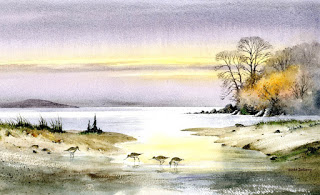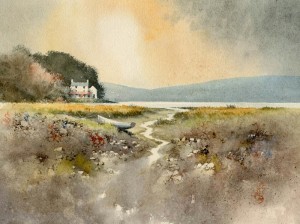Many people find painting boats a challenge, and although they love working on harbour or coastal scenes where boats are featured, it is often the rendering of the boats that lets them down. Some boats, of course, are notoriously complicated and awkward even for the professionals, but here I’d like to offer some help and a few tips for those who find these fascinating subjects rather a struggle.
This watercolour is part of a small painting on Waterford 300lb rough paper, where I have included a few small dinghies that together with the figures form the focal point of the composition. Pushing boats into the middle distance like this makes them considerably simpler, and yet they can still be the centre of interest. By having them broadside on to the viewer you will eliminate those often excruciatingly difficult curves which may be present when you look at them from a side angle, but you can still give them a gentle rake where the top of the gunnel curves slightly upwards to the prow. If you are working on a reasonably large boat that is broadside on, closer to the foreground then use the shallower curve of French Curves to help you. With more experience work on more challenging boats.
Keeping the figures close to the boats emphasises the two elements as a focal point, but you can also use figures to hide those parts of the boat you may find awkward. Tarpaulins, netting, buoys, oars, lobster pots and all manner of seafaring detritus can also be used to break up parts of boats, as well as adding colour. Of course, you may be painting a truly picturesque harbour and find the main boat in the scene is a complicated mess and not at all attractive. Leave it out and substitute another, more handsome craft to your liking. It pays to sketch and photograph really good individual boats from all angles and at a variety of distances so that you can use these as substitutes in a composition.
A few years ago I filmed a number of scenes painting on the coast aimed at a DVD to release with my Seas & Shorelines book, but I mislaid the footage and the book came out on its own. However, I found the coastal footage a while back and this has now been produced as a new Seas & Shorelines DVD, which can be bought on its own or as a special book & dvd offer and this is solely available from my website. It contains many tips on painting boats as well as other maritime subjects. There is also a clip of the DVD on You Tube.
This is not the best time of year for getting out to sketch in the landscape, but given the problem with Coronavirus you may well feel the effort is worthwhile. I spend a lot of time outdoors and on Saturday went up the Black Mountains to paint some snow scenes. Being out in nature is one of the best antidotes to our current situation, but make sure you wrap up warm. I visited Cotswold Outdoor a few days ago to get some new sketching gloves and they have two or three excellent versions which are thin, warm and ideal for sketching in cold conditions. There are naturally many tips for working outdoors in winter in my Landscapes Through the Seasons in Watercolour book.
Enjoy your painting!





